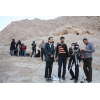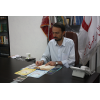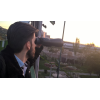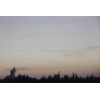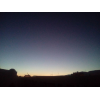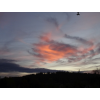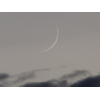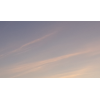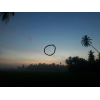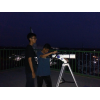Visibility of Safar Crescent 1439 AH
- When to Observe Safar Waxing (NEW) Crescent ?
- Safar Waxing (NEW) Crescent Observation Results
- The OFFICIAL First Day in Different Countries
- When to Observe Muharram Waning (OLD) Crescent ?
- Muharram Waning (OLD) Crescent Observation Results
When to Observe Safar Waxing (NEW) Crescent ?
The geocentric conjunction (Geocentric New Moon) will occur Inshalla on (Thursday 19 October 2017) at 19:12 UT.
Sighting the new crescent on (Thursday 19 October 2017) and (Friday 20 October 2017) is shown in the below graphs using the program Accurate Times by Mohammad Odeh according to Odeh criterion. Where:-
- It is impossible to see the crescent from the areas located under the red color. Because either the Moon on this day sets before the Sunset and/or the topocentric conjunction occurs after the Sunset.
- The crescent is expected to be seen by optical aid only from the areas located under the blue color.
- The crescent is expected to be seen by optical aid from the areas located under the magenta color. In these areas the crescent could be seen by naked eye if the atmospheric conditions are superb and the observer is experienced.
- The crescent is expected to be easily visible by naked eye from the areas located under the green color.
- The crescent cannot be seen from uncolored areas, even though the Moon sets in these locations after the Sunset and the topocentric conjunction occurs before the Sunset, but the Moon is not sufficiently illuminated in order to be seen as crescent even by optical aid.
- Kindly notice that the below graph shows the possibility of seeing the crescent from areas between 60 degrees north of Equator down to 60 degrees south of Equator.

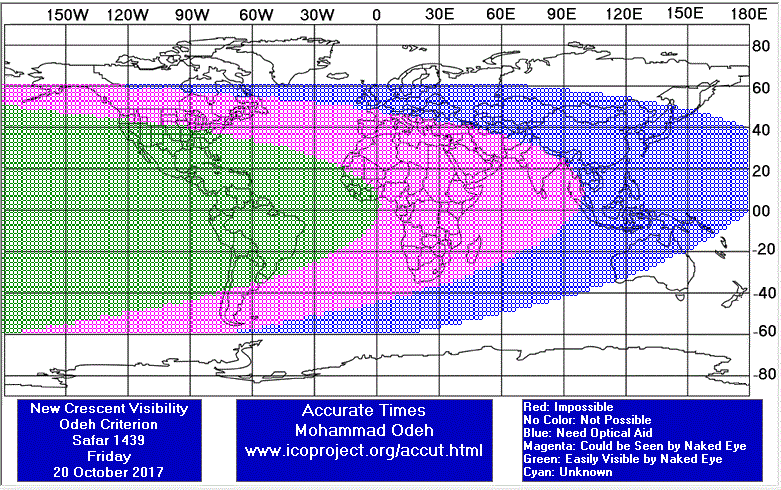
According to the Universal Hejric Calendar (UHC), which is based on the calculated crescent visibility, the start of this month in the Eastern Region will be on Saturday 21 October 2017 and in the Western Region will be on Saturday 21 October 2017. Kindly notice that the UHC is a pre-calculated calendar, which adopts a certain criterion to start the new Hejric month. Your country/organization might adopt different criterion to start the new Hejric month. So it is highly advised to read the UHC website before giving any judgment.
- Results of seeing the crescent, and the first day of the month in different countries will be added here Inshalla as we receive the reports from ICOP's members. If you wish to be a member in ICOP, or to know more about it, kindly click here.
Safar Waxing (NEW) Crescent Observation Results
Fri 20 October 2017
Australia
Hungary
Iran
Mr. Hossein Janghorbani said: "In the name of God Safar Crescent Observation Report The Astronomy and Geophysics Center of Shahreza – The Crescent Association of Shahreza Report by: Hossein Janghorbani (Najmosepehr-Sadrolmonajjemin) – Manager of Shahreza Crescent Association and Red Crescent’s Astronomy and Geophysics Center Date: Friday, 10/20/2017 Location: Damzad foothills in the East of Shahreza (latitude: 32 00 N, longitude: 51 52 E, elevation: 1825m from sea level, time zone: +3.5 GMT) Equipments: Two sets of 15*70 binoculars, One sets of 20*90 binoculars, One sets of 25*100 binoculars, One sets 3-inch telescope with a monitor, One compass. Atmospheric condition: hazy. Horizon obstacles: 2.5° Apparent sunset: 17:14 Results: Moon crescent was seen by 15*70 binoculars by Hossein Janghorbani at 17:41 , at 17:42 , at 17:43, for the first time. Moon crescent was seen by 20*90 binoculars by Mohammad Javad Nikeghbal at 17:48. Moon crescent was seen by 20*90 binoculars by Mohadeseh Alinezhad and Masoomeh Hafar at 17:50. Moon crescent was seen at 17:48, at 17:49 , at 17:50 By Alireza Salmani, Morteza Akaf, Alaeddin Kerdegar and other observers on the telescope monitor. At the end of this program a report from computing and writing Astronomical Calendar 1397 year (According to the official calendar of Iran) By Mr. Hossein Janghorbani With Background 22 years old In science Astronomy and ... was presented. Observers: 1.Morteza Akaf 2.Alireza Salmani 3.Alaeddin Kerdegar 4.Abdolreza Gholami 5.EhsanAli Alinezhad 6.MohammadMahdi Jambakhsh 7.MohammadJavad Nikeghbal 8.MohammadSadra Nikeghbal 9.Sayed Farzad Alavi 10.Sepehr Hafar 11.Saer Aliabedi 12.Ali Aghabozorgi 13.Ali Janghorbani 14.Hossein Janghorbani 15.Zahra Jamali 16.Zohreh Karimpoor 17.Fatemeh Haddad 18.Shahideh Torabi 19.Toktam Aliabedi 20.Masoomeh Hafar 21.Ziba Hafar 22.Narjes Zare 23.Mohadesseh Alinezhad 24.Misagh Alinezhad 25.Zahra Fallahi "
Mr. Hossein Janghorbani said: "Mr.Reza Janghorbani based in the city of Tabriz in East Azerbaijan province due to hazy weather, Not see the crescent moon."
Morocco
Mr. Abdessamad Doukkane said: "قامت جمعية المبادرة المغربية للعلوم والفكر بمراقبة هلال صفر بالناظور مع مندوبية الأوقاف والشؤون الإسلامية, ولم تتم رؤيته وتتوقع الجمعية حسب بيانها لشهر صفر رؤيته بالاقاليم الجنوبية"
Oman
Prof. Mohammed Al-Bussaidi said: "تم رؤية هلال شهر صفر 1439هــ ، باستخدام المنظار من خلال العدسة العينية ومن خلال كامرة السي سي دي من منطقة الفليج، سلطنة عمان"
Palestine
Saudi Arabia
Mr. Turki Alamri said: "i setup my system when the crescent is in the AZ 12:00 pm but i manage to take some images for it . with AOD 0.14 for 619 nm the crescent was not easy to see ! i hope i manage to image it after sunset i used a 685 nm filter."
United Arab Emirates
United States
Dr. Javad Torabinejad said: "I arrived at my sighting location at 6:27 pm EDT (sunset: 6:39 pm; apparent sunset: 6:33 pm). Using a pair of binoculars (7x50), I started looking for the crescent in a mostly clear western horizon. My first optical aided sighting was at 6:45 pm followed by my naked-eye sighting eleven minutes later at 6:56 pm. During the session, a friend joined me; he was using a pair of (10x50) binoculars. He also sighted the crescent through the binoculars and then with naked eye. The crescent was very thin with its horns at 2:30 and 6:30 O'clock (2:30;4:30;6:30). It was setting when we left the site at 7:27 pm (moonset: 7:32 pm)."
Sat 21 October 2017
Germany
Eng. Martin Elsaesser said: "After clouds prevented us from seeing the crescent yesterday today the gaps were more helpful and the crescent much easier to see. The crescent was seen easily with binoculars and naked eye."
Indonesia
Mr. AR Sugeng Riyadi said: "The new crescent of Shafar 1439 AH was sighted from TopRoof of Darussalam Islamic Boarding School at Blokagung Banyuwangi on Saturday, Oktober 21st, 2017. The sky was clear n rather cloudy. My students of CASA in Sukoharjo also cloud see the new crescent of Shafar 1439 AH today from Assalaam Observatory at PPMI Assalaam Pabelan Kartasura Sukoharjo Central Java Indonesia."
Morocco
Dr. Hassan Talibi said: "رغم أن الراصدين المشاركين في المشروع لم يتمكون من رصد الهلال البارحة فإن رؤيته كانت ممكنة في الأقاليم الجنوبية المتقدمة غربا ولذا أعلنت وزارة الأوقاف المغربية البارحة عن ثبوته ثبوتا شرعيا. "
Palestine
The OFFICIAL First Day in Different Countries
Sat 21 October 2017
1 . Bahrain
2 . Indonesia
3 . Iran
4 . Jordan
5 . Kuwait
6 . Morocco
7 . Oman
8 . Qatar
9 . Saudi Arabia
10 . United Arab Emirates
Sun 22 October 2017
1 . Australia
When to Observe Muharram Waning (OLD) Crescent ?
The geocentric conjunction (Geocentric New Moon) will occur Inshalla on (Thursday 19 October 2017) at 19:12 UT.
Sighting the OLD crescent on (Thursday 19 October 2017) and (Wedensday 18 October 2017) is shown in the below graphs using the program Accurate Times by Mohammad Odeh according to Odeh criterion. Where:-
- It is impossible to see the OLD crescent from the areas located under the red color. Because either the Moon on this day rises after the Sunrise and/or the topocentric conjunction occurs before the Sunrise.
- The crescent is expected to be seen by optical aid only from the areas located under the blue color.
- The crescent is expected to be seen by optical aid from the areas located under the magenta color. In these areas the crescent could be seen by naked eye if the atmospheric conditions are superb and the observer is experienced.
- The crescent is expected to be easily visible by naked eye from the areas located under the green color.
- The crescent cannot be seen from uncolored areas, even though the Moon rises in these locations before the Sunrise and the topocentric conjunction occurs after the Sunrise, but the Moon is not sufficiently illuminated in order to be seen as crescent even by optical aid.
- Kindly notice that the below graph shows the possibility of seeing the crescent from areas between 60 degrees north of Equator down to 60 degrees south of Equator.
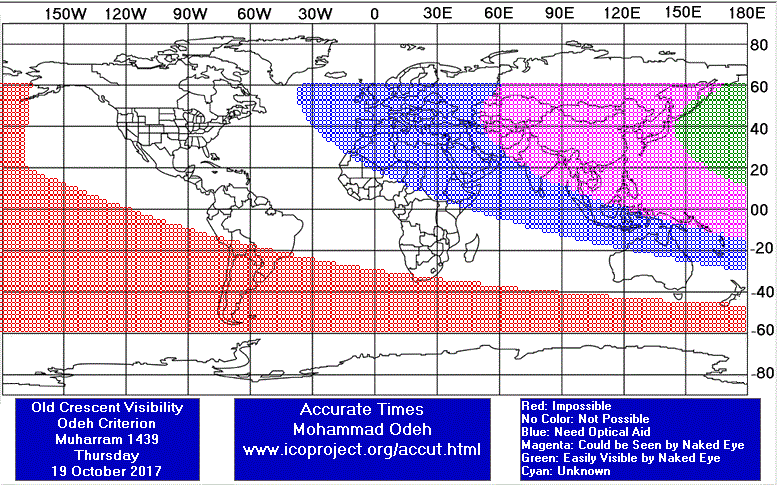

Muharram Waning (OLD) Crescent Observation Results
Wed 18 October 2017
Indonesia
Mr. AR Sugeng Riyadi said: "The old crescent of Muharram 1439 H was not sighted on Wednesday, Oct 18, 2017 from Assalaam Observatory by my students of CASA (Club Astronomi Santri Assalaam) because the sky was totally cloudy. The moon was seen my mr. Isma'il Alfalaky from Aceh, Nort Sumatera and from Malang East Java by mr. Harno Abu Sholih."
Palestine
United States
Thu 19 October 2017
Germany
Eng. Martin Elsaesser said: "I went out to observe the old crescent this morning, which was perfectly located at a close elongation of only 7.2°. Conditions were fine with good transparency. Venus was used for alignment. After slewing the mount to the position of the crescent it was immediately visible with the imaging system. I tracked it for about 15 minutes. I tried to see the crescent visually with the same telescope but could not. I feel it might have been possible under perfect conditions but i did not have the time to drive to the mountains this time."
Indonesia
Mr. AR Sugeng Riyadi said: "The daytime old crescent of Muharram 1439 H was not seen on Thursday, 19 October 2017 from Rowasiya Observatory at Bendo Ketitang Juwiring Klaten Central Java Indonesia. The sky was very hazy and cloudy."

